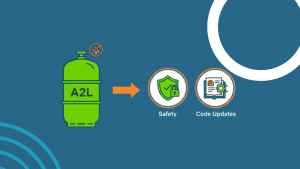If you want to pursue a career in the HVAC field, you require certain important credentials. One of the most widely accepted certificates is the “608 Certification” mandated by the U.S. Environmental Protection Agency (EPA). In simple words, it is a kind of license that proves a technician understands how to properly handle refrigerants in compliance with environmental laws.
Now arises a question: why is this credential most important in the HVAC industry? The reason is: it protects the environment along with HVAC businesses and professionals from legal penalties. And one of the most important aspects is that it shows employers and customers are qualified and can do their job right.
In this blog today, let’s explore more about 608 certificates powered by EPA and how it is important for anyone working with HVAC systems.
Understanding the Different Types of 608 Certification
EPA has divided this certification into four major types with a unique focus on different equipment and refrigerant handling situations. Let’s learn about them below in-depth.
Type I Certification – Small Appliances
Type I is for the HVAC technicians who work with small-scale machines like household refrigerators, window ACs, and vending machines.
Type II Certification – High-Pressure Appliances
Type II is considered important if you want to work on high-pressure systems such as commercial air conditioning units and supermarket refrigeration systems. This certificate is a must to be a part of installing, maintaining, and disposing of these larger systems.
Type III Certification – Low-Pressure Appliances
For low-pressure units, including chillers (commonly found in industrial or large-scale commercial buildings), Type III credentials are mandatory. They make sure that the hired technician has specialized knowledge of leak detection, recovery techniques, and safe handling practices.
Universal Certification
The combination of Type I, Type II, and Type III is called Universal Certification. If you want maximum flexibility in your HVAC career, this credential is ideal for you, as it ensures that you can work on virtually any system needing regulated refrigerants.
EPA 608 Certification Requirements
Before you finally appear for the exam to receive EPA 608 credentials, it’s very important to understand the eligibility criteria. Broadly, EPA has set no such strict standards for application. Even if you do not have any prior job experience, formal education, or licensing, you can still appear for this test.
However, there are many technicians who prefer completing an HVAC training program first and then pursuing an EPA 608 certificate from either an HVAC trade school or a certified college. It gives them practical knowledge and understanding about refrigeration systems, safety practices, and regulations set by the EPA.
Now, you might be thinking which type of EPA certification you should go for? To sort that out, simply note down the systems you will be working with. Do you want to start with household appliances? Then, Type I is the most suitable option. On the other hand, if you aim for full flexibility and broader job opportunities in the HVAC industry, you should go for EPA 608 Universal Certification.
The 608 Certification Exam Explained
If you ask how to get EPA 608 certification, the answer is to appear for a written exam that will test your understanding and knowledge of how safely you can handle refrigerants. It is a universal test for all types of 608 credentials, whether you choose to go for Type III or Universal Certification.
In the exam, there is a Core Section that involves important topics of ozone depletion, refrigerant recovery and recycling, safety practices, and EPA rules and regulations. Additionally, you will also take one or more specialised sections based on your chosen certification level. In each section, there would be 25 MCQs, and you must score at least 72% to pass.
Important Topics Covered in the 608 Certification Exam
This written test covers the following most important aspects:
- Environmental impact of refrigerants
- Safe refrigerant recovery and disposal
- Leak detection and repair requirements
- System charging and evacuation procedures
- Specific handling techniques for different pressure appliances
To prepare for these subjects, you can choose self-study guides, online courses, and even HVAC training programs that offer how to prepare for the examination. However, if you choose EPA 608 certification online, ensure that the provider is approved by the EPA and meets all the official standards.
Quick Tips to Crack the Exam
Whether you opt for online or offline learning, proper preparation is the only key to passing the 608 test. Here are a few helpful aspects for you:
- Focus on the Core Sections
- Understand the difference between low and high-pressure systems
- Use flashcards or practice tests to understand the question formats from PYQs
- Review EPA regulations carefully
How Much Does EPA 608 Certification Cost?
When you plan to earn your 608 certification from the EPA, understanding the cost is a crucial factor as it prepares you both financially and logistically. For the exam fees, you can estimate a charge between $25 and $150, depending on the type you choose and where you appear for the test. If you go for in-person testing, they might charge a bit extra. There are many 608 certification online platforms as well that provide affordable and convenient testing options.
In case you opt for an HVAC training program before appearing for the final exam, an additional cost will be up. The online prep courses and study materials will cost you, ranging from $20 to $100. On the other hand, if you go to an HVAC trade school, they will also include the certification exam as part of the tuition.
Want to explore how certifications can kickstart your HVACR career?
Read this blog: Launch Your Career in HVACR: Certifications and Skills That Matter
How to Get Your 608 Certification?
Now, let’s understand the step-by-step process to obtain an EPA 608 certification:
Choose the Right Certification Type
First things first: decide whether you want to pursue Type I, II, III, or Universal Certification. If you are not sure, go for an all-in-one approach, i.e. universal credential, as it covers all areas of the HVAC field. Ultimately, you will have flexibility in the end to choose from a variety of domains.
Study the Exam Material
Take help from study guides, online resources, or enroll in an EPA-approved preparation course. You can also avail of EPA 608 certification online programs that offer training and testing options clubbed together.
Select a Test Provider
You have options to either go in-person or online through an EPA-certified proctor.
Take and Pass the Exam
In the test, you will find a mandatory core section and your chosen certification type. Most testing services often provide instant or fast results. So, you would get to know right away if you have passed.
Receive your Certification and EPA Number
Once you clear the examination, you will get a physical or digital certificate in addition to a unique EPA technician certification number.
As you are done, you are officially authorised to work with refrigerants and pursue a compliant HVAC career.
Benefits of Being 608 Certified
As you understand how to get EPA 608 certification and crack it finally, there are numerous advantages awaiting you:
Career Advancement Opportunities
In today’s times, employers prefer HVAC technicians with 608 certification by EPA. So as you get one, you open the door to a number of advanced job positions that pay better and offer broader responsibilities in both residential and commercial sectors.
Legal and Environmental Compliance
The EPA is the authority that regulates the handling of refrigerants. Being certified means that you operate within federal laws, and there won’t be any serious penalties for you. To learn more about HVAC licensing and legal obligations in Nevada, refer Licensing and Compliance in Nevada’s HVACR Industry.
Job Security and Trust with the Hiring Manager
HVAC companies look for technicians who are skilled and certified to do the job correctly. A 608 certification from the EPA ensures that you understand how to handle units safely. As a result, it builds trust with your team leader and gives you long-term job security.
Common Myths and FAQs About 608 Certification
Many people often have confusion and many questions about the 608 certificates approved by the EPA. Let’s discuss them today and give you clarity.
1. Does the 608 certification by EPA expire?
Ans. No, EPA 608 credentials do not expire at all. Instead, they are valid for a lifetime. Hence, you do not need to worry about any renewal or recertification.
2. Can I work in HVAC without a certificate?
Ans. If you are not handling refrigerants, then you can be a part of the HVAC industry without any particular certification. However, there can be penalties if you repair, service, or dispose of HVAC systems without any official approval.
3. What does section 608 certification allow a technician to do?
Ans. After obtaining a 608 certificate from the EPA, you can legally work with low or high-pressure systems depending on your certification type.
4. Do I need to take all four sections in the EPA 608 exam?
Ans. No, you only need to opt for sections that are relevant to your work. However, choosing Universal Certification gives you the maximum flexibility to change job roles if needed later on.
5. Is it safe to appear for the EPA 608 exam online?
Ans. Yes, it is legal to take an online exam from an EPA-approved provider.
Conclusion
Overall, an EPA 608 credential offers one of the smartest and essential steps to pursue your career in the HVAC industry. Whether you go with only Type I or II or III or avail a Universal Certification, you learn the legal requirements to handle components safely. Plus, there is no expiration of the EPA 608 certificate. So, it is a kind of one-time investment that gives a lifetime of infinite benefits in the HVAC field.


